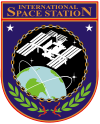- Node Module
-
"Node Module" redirects here. For other uses, see Node Module (disambiguation).
The Node Module (NM) is a pressurized module of the Russian Segment (RS or ROS) of the International Space Station (ISS) and will be used in the OPSEK space station. NM is being developed by RSC Energia in order to support the docking to ISS RS of two scientific and power modules during the final stage of the segment assembly and to provide on this segment additional docking ports to receive Soyuz TMA and Progress M spacecraft. NM is to be incorporated into ISS in 2012.
Contents
Launch
The Node Module would be integrated with a special version of the Progress cargo ship and launched by a standard Soyuz rocket. The Progress would use its own propulsion and flight control system to deliver and dock the Node Module to the nadir (Earth-facing) docking port of the Nauka MLM/FGB-2 module on the Russian segment of the ISS.
Design
The Nadir (earth-facing) docking port will support automated transfer of propellants between docked Russian spacecraft and the ROS in both directions, and automated docking of manned and unmanned spacecraft using the Kurs radio telemetry system. According to the stations normal orientation, the module will provide the following ports, Zenith (top) one Active Hybrid, 4 Passive Hybrid and one Nadir Passive Transformed Hybrid, which is able to support Active Hybrid and Active Standard Probe spacecraft. The docking compartment has an internal volume of 14 cubic meters.
History
In the mid-2000s, RKK Energia added the UM to the future configuration of the ISS. Despite its small size, this four-ton, ball-shaped module could play an extremely important role in the Russian space program.
The first task of the module would be to enable the addition of a pair of science and power modules, NEMs, to the Russian segment, which were intended to replace a canceled Science and Power Platform, NEP. However more importantly, the node module was conceived to serve as the only permanent element of the future Russian successor to the ISS, OPSEK. Equipped with six docking ports, the Node Module would serve as a single permanent core of the future station with all other modules coming and going as their life span and mission required. This would become a new generation of space station, beyond Russia's MIR space station and the ISS , which are more advanced than early monolithic first generation stations, such as Salyut, Almaz, and Skylab.
The Preliminary design was completed on Jan. 15, 2011,when RKK Energia announced that its Scientific and Technical Council, NTS, conducted a meeting, which reviewed and approved the preliminary design of the Node Module and associated hardware. The meeting also approved the specialized launch craft, a Progress cargo ship designated the Progress M–UM and the adaptation of the Soyuz rocket for the launch of the Progress M-UM spacecraft-module;[1]
References
External links
- Images
Line diagram of module and progress robot spacecraft
See also
- Orbital Piloted Assembly and Experiment Complex - proposed separation of parts of ROS
Components of the International Space Station Overview Assembly · US Orbital Segment · Russian Orbital Segment · Expeditions · Spacewalks · ISS Program · Scientific Research · Major Incidents
Major components
in orbitZarya (Functional Cargo Block) · Zvezda (Service Module) · Unity (Node 1) · Harmony (Node 2) · Tranquility (Node 3) · Destiny (Laboratory) · Columbus (Laboratory) · Kibō (PM, ELM-PS, EF) · Quest (Airlock) · Pirs (Airlock / Docking Module) · Rassvet (MRM 1) · Poisk (MRM 2) · Leonardo (PMM) · Cupola · Integrated Truss Structure (ITS)Subsystems
in orbitFlight-ready hardware
with no launch planScheduled for launch
by ProtonProposed module Cancelled Support vehicles Current: Soyuz · Progress · Automated Transfer Vehicle (ATV) · H-II Transfer Vehicle (HTV)
Future: Dragon · Cygnus · Orion · Rus · CST-100
Former: Space ShuttleMission control centers  Book:International Space Station ·
Book:International Space Station ·  Category:International Space Station ·
Category:International Space Station ·  Portal:Spaceflight
Portal:SpaceflightExpeditions to the International Space Station Current Expedition 29Planned Expedition 30 • Expedition 31 • Expedition 32 • Expedition 33 • Expedition 34 • Expedition 35 • Expedition 36 • Expedition 37 • Expedition 38 • Expedition 39 • Expedition 40 • Expedition 41Completed Expedition 1 • Expedition 2 • Expedition 3 • Expedition 4 • Expedition 5 • Expedition 6 • Expedition 7 • Expedition 8 • Expedition 9 • Expedition 10 • Expedition 11 • Expedition 12 • Expedition 13 • Expedition 14 • Expedition 15 • Expedition 16 • Expedition 17 • Expedition 18 • Expedition 19 • Expedition 20 • Expedition 21 • Expedition 22 • Expedition 23 • Expedition 24 • Expedition 25 • Expedition 26 • Expedition 27 • Expedition 28 Book:Expeditions to the ISS ·
Book:Expeditions to the ISS ·  Category:Expeditions to the ISS ·
Category:Expeditions to the ISS ·  Portal:Spaceflight
Portal:SpaceflightSpace stations and habitats Active Defunct Soviet Union
and RussiaUnited StatesCancelled ISS-incorporated Developmental ChinaSpace Complex Alpha · Space Complex BravoRussiaOPSEK · LOSProposed Rotating wheel · Bernal sphere · O'Neill cylinder · Stanford torus · Wet workshop · Space habitat · Industrial Space Facility · Orbital Technologies Commercial Space Station1 Never inhabited 2 Failed launch 3 Part of the Almaz military program Soviet and Russian government manned space programs Active Past Cancelled Spaceflight General 
Applications Earth observation satellites (Spy satellites · Weather satellites) · Private spaceflight · Satellite navigation · Space archaeology · Space architecture · Space colonization · Space exploration · Space medicine · Space tourismHuman spaceflight GeneralHazardsMajor projectsApollo · Constellation · Gemini · International Space Station · Mercury · Mir · Shenzhou · Soyuz · Space Shuttle · Voskhod · VostokSpacecraft Destinations Space launch Space agencies Categories:- International Space Station
- Artificial satellites orbiting Earth
- Human spaceflight
- Joint ventures
- Manned spacecraft
- Populated places
- Spaceflights
- Space stations
- Russian components of the International Space Station
Wikimedia Foundation. 2010.


